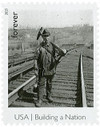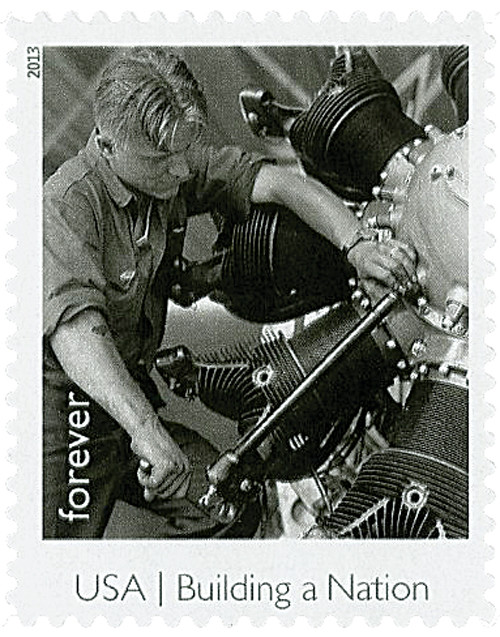
# 4801j - 2013 First-Class Forever Stamp - Made in America: Railroad Track Walker
US #4801j
2013 Railroad Track Walker – Made in America
- One of 12 stamps celebrating the industrial workers who brought America into a new age
Stamp Category: Commemorative
Set: Made in America
Value: 46¢ First Class Mail Rate (Forever)
First Day of Issue: August 8, 2013
First Day City: Washington, D.C.
Quantity Issued: 2,500,000
Printed by: Avery Dennison
Printing Method: Photogravure
Format: Panes of 12
Why the stamp was issued: To honor railroad track walkers and their important work that supported transportation of goods and services across America.
About the stamp design: Pictures a black and white vintage photograph by Lewis Hines of a railroad track walker at work.
First Day City: The First Day of Issue Ceremony was held at the Frances Perkins Building, part of the Department of Labor in Washington, DC.
About the Made in America set: Includes 12 different stamp designs picturing black and white vintage photographs of male and female industrial workers. Eleven were taken by photographer Lewis Hine, with the twelfth by Margaret Bourke-White. The USPS said “Stamps are like a miniature American portrait gallery. They are an expression of our values and a connection to our past. That’s why it’s so fitting that this series depicts Americans at work. These iconic images tell a powerful story about American economic strength and prosperity. These men and women and millions like them really did build a nation.”
History the stamp represents: A single lantern swings back and forth along the railway. The safety of train passengers depends on the person holding the lantern. The track walker inspects every rail, switch, and bolt in his 10-mile section making sure it is ready for the trains to run the next day.
In the 1880s, track walkers were often irish immigrants who had helped build the Transcontinental Railroads. The position required “an experienced and reliable man,” according to a manual of the time.
Along with his lantern, the track walker carried red flags, wrenches, extra bolts, and “torpedoes” – loud warning devices placed on the track to signal the engineer to stop the train.
Though some track walkers had day shifts, most worked at night to avoid rail traffic. They were often the only humans traveling along their sections. The job had to be carried out every night, in spire of the weather. The rail inspectors also alerted section crews of downed trees and landslides blocking the tracks.
The track walkers carried out their solitary routine, keeping the rails maintained and probably preventing scores of tragedies. Because of those diligent men, America’s railways developed into the thriving network they are today.
US #4801j
2013 Railroad Track Walker – Made in America
- One of 12 stamps celebrating the industrial workers who brought America into a new age
Stamp Category: Commemorative
Set: Made in America
Value: 46¢ First Class Mail Rate (Forever)
First Day of Issue: August 8, 2013
First Day City: Washington, D.C.
Quantity Issued: 2,500,000
Printed by: Avery Dennison
Printing Method: Photogravure
Format: Panes of 12
Why the stamp was issued: To honor railroad track walkers and their important work that supported transportation of goods and services across America.
About the stamp design: Pictures a black and white vintage photograph by Lewis Hines of a railroad track walker at work.
First Day City: The First Day of Issue Ceremony was held at the Frances Perkins Building, part of the Department of Labor in Washington, DC.
About the Made in America set: Includes 12 different stamp designs picturing black and white vintage photographs of male and female industrial workers. Eleven were taken by photographer Lewis Hine, with the twelfth by Margaret Bourke-White. The USPS said “Stamps are like a miniature American portrait gallery. They are an expression of our values and a connection to our past. That’s why it’s so fitting that this series depicts Americans at work. These iconic images tell a powerful story about American economic strength and prosperity. These men and women and millions like them really did build a nation.”
History the stamp represents: A single lantern swings back and forth along the railway. The safety of train passengers depends on the person holding the lantern. The track walker inspects every rail, switch, and bolt in his 10-mile section making sure it is ready for the trains to run the next day.
In the 1880s, track walkers were often irish immigrants who had helped build the Transcontinental Railroads. The position required “an experienced and reliable man,” according to a manual of the time.
Along with his lantern, the track walker carried red flags, wrenches, extra bolts, and “torpedoes” – loud warning devices placed on the track to signal the engineer to stop the train.
Though some track walkers had day shifts, most worked at night to avoid rail traffic. They were often the only humans traveling along their sections. The job had to be carried out every night, in spire of the weather. The rail inspectors also alerted section crews of downed trees and landslides blocking the tracks.
The track walkers carried out their solitary routine, keeping the rails maintained and probably preventing scores of tragedies. Because of those diligent men, America’s railways developed into the thriving network they are today.








